In 2016, Montclair State University was given the status of being a Hispanic-Serving Institution (HSI). Many question exactly what this designation means for its Hispanic students.
Dr. Katia Paz Goldfarb, associate provost for Hispanic Initiatives and International Programs, shared how Institutions become HSIs.
“We are not born a [Hispanic Serving-Institution], we become a [Hispanic-Serving Institution],” Goldfarb said. “It is a designation that is federally designated. The federal government decided that once an institution of higher education, which could be community college or universities, four-year institutions, [arrives] to 20 percent, 25 percent of their undergraduate students that self identify as Latinos, you are a [Hispanic-Serving Institution].”

Dr. Katia Paz Goldfarb, associate provost for Hispanic Initiatives and International Programs, shared how Institutions become HSIs. Dani Mazariegos | The Montclarion
The designation is also dependent on students’ financial needs.
“There is another part of it. [It’s that] you have to be also a university where the financial aid is high, the need for financial aid is high but the bigger part is really enrolling,” Goldfarb said.
Genesis Rodriguez, a junior psychology major, praises Montclair State for being an inclusive Hispanic-serving community.

Genesis Rodriguez, a junior psychology major, appreciates the many programs available for Hispanic students at Montclair State. Photo Courtesy of Sean Kuhn
“[Especially] since I am a transfer student and I come from a school that was not very inclusive,” Rodriguez said. “Montclair [State] has a lot of programs, especially for Hispanic students that I always see. They are always inclusive with the students with the events, opportunities, [and] scholarships that I’ve been seeing.”
Goldfarb said that bringing opportunities to the Montclair State Hispanic student body is not about looking at what they lack but how they can be supplemented for their growth.
“[I make an effort to bring] the resources into the university in my office,” Goldfarb said. “Not necessarily because of the deficit perspective of the Latino student coming [into my office], which is ‘Oh, what is it that you need? [What are] your challenges?’ and all of that, but actually to provide you with the opportunities.”
Dr. Laura Quiros, associate professor for social work and child advocacy, explains how she shares her background with students and encourages them to also share their identity.
“What I offer my students is my vulnerability around sharing my identity with them,” Quiros said. “I think that that offers students the opportunity to also share their identities. I think one of the most beautiful things about our institution is that we are a Hispanic-Serving Institution and within that identity, so complex, so multifaceted. So I offer my vulnerability around my identity to students so that they can share, that they’re not only Hispanic, but they’re Colombian, they’re Ecuadorian, they’re Puerto Rican, they’re Dominican, they’re Cuban and that we can embrace all of that identity and understand that although we may fall under this one category, our values are different, our cultural norms are different. Sometimes even the way we identify racially is different.”
Quiros found that growing up, she did not feel secure in her identity until graduate school because of a lack of diversity at her undergraduate alma mater.
“So I think in my undergraduate years it felt very isolating except for one or two close friends that I had, and we were kind of all exploring our identity, but then it wasn’t until my graduate and Ph.D. program [that I no longer felt isolated],” Quiros said. “I think that also had to do with my stage of development. I really started to understand what this identity meant to me. I think I’ve experienced lots of discrimination at different points in my life related to my Latina identity as somebody who is dark-skinned, especially in the summer and [has] curly hair. So there was always a trying to assimilate into a white culture.”
Dr. Milton Fuentes, a psychology professor, shares what he believes is important for Hispanic students and what they need to hear from Hispanic professors and staff.
“I think it’s important for students to see themselves, [represented] across the campus not just as faculty but in terms of staff and other students as well,” Fuentes said. “[Students] see my last name, Fuentes, that’s a good start but it’s not enough. I think they also need to hear my story. They need to hear that I’m Puerto Rican. They need to hear that my parents came here from Puerto Rico. They need to hear that my mom has a second-grade education.”
Fuentes said he wants the Hispanic student community to know that they have potential, resources and people they can turn to.
“I would like students to feel like they matter at Montclair [State],” Fuentes said. “To feel that they belong at Montclair [State]. I would also like them to know that there are people at Montclair [State] who really care about them and want to support them in terms of realizing their goals and dreams. To know there are a lot of resources and I hope they can feel comfortable taking advantage of these resources. Research has shown that when students reflect on their values, it gives them a sense of purpose and meaning and it helps them succeed. If they ever feel disenchanted, pause and reflect. Why are you doing this? What’s your purpose in life?”
Students shared their thoughts on Montclair State’s status as an HSI.
Kara Urena, a sophomore psychology major, shares her opinion and experience as a Hispanic on campus.

Kara Urena feels Montclair State University is doing its part as a Hispanic Serving Institution. Lynise Olivacce | The Montclarion
“I think that [Montclair State University is] inclusive,” Urena said. “We see a lot of Hispanic students on campus. I’ve been to many events like the [Latin American Student Organization].”
Jordan Walters, a sophomore fashion design major, expresses some ways Montclair State can improve on being an HSI.

Walters, a fashion design and merchandising major feels celebrations of Hispanic Heritage should be spread more throughout campus. Lynise Olivacce | The Montclarion
“I feel we could have more open events on campus,” Walters said. ”Not just in a specific area like the Quad. We could have it all over campus, ranging from Freeman Hall to Blanton [Hall] and just have a big celebration with food, music, parties and just have a lot of fun.”



